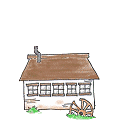The EPA funded study says that if you achieve 100% combustion (carbon and gases from pryolysis) you will achieve just over 15,000 BTU’s per pound of wood.
This is actually an interesting presentation. It does
not say 15,000 BTU's per pound.
On page 3, it says 8600 BTU's/pound for hardwoods and 9000 BTU's/pound for softwood. Bituminous coal is 10-14,000 BTUs. Page 11 lists the conditions for good wood combustion. These conditions are the goal of the j-tube combustion system.
For the record, 100% combustion is only possible when using pure oxygen, not the ~19% oxygen atmosphere we are breathing. The upper limit is probably about 95%.
On the Dragon Heaters website, for our "what you can expect" calculations, we used 5,600 - 6,000 BTU/pound of wood. During the intense part of the burn, we recorded 85% to 93% combustion efficiency with Peter van den Berg's j-tube design. These efficiency numbers were logged by a Testo gas analyzer.
It requires vastly different combustion conditions to burn wood than gas. Gas (Propane & Natural) is relatively easy and can be done with a metal jet. The people building metal rocket stoves don't understand or don't want to. They are probably also desperate to lower their fuel bill.

 1
1




 1
1




 1
1







































